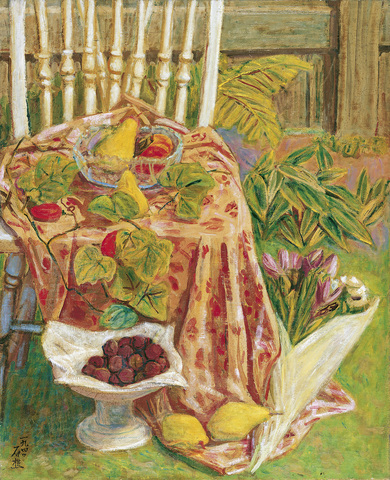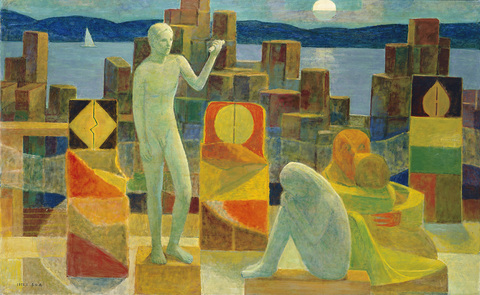Three of Li Shih-chiao's (李石樵) paintings adorn the walls of the Presidential Office, which is a testament to the respect he earned in his lifetime. To celebrate the one-hundredth anniversary of the artist's birth, the Taipei Fine Arts Museum (TFAM) will hold a retrospective of his work beginning Feb. 16.
The curators at TFAM arranged the exhibit to chart Li's development as an artist, bringing together paintings that span his long career and provide a context to show the influence he had on later generations of artists.
"You have to be determined, and willing to bear hardship," Li once remarked. "My whole life, I've seriously pursued one thing: how to paint my paintings well."

PHOTOS COURTESY OF TFAM
The exhibit, which reveals Li's interest in Western and Eastern artistic styles, is arranged chronologically in three sections titled refinement, metamorphosis and light.
Early in his career, Li studied under the Japanese masters Ishikawa Kinichiro and Yoshimura Yoshimatsu, painting the people and scenery of Taiwan with sparse brush strokes and solid, brilliant colors.
The first section includes paintings from the late 1920s and early 1930s, when Li was refining his style at the prestigious Tokyo School of Art. During this period he adhered to a form of realism and French Impressionism that found expression in portraits and landscapes from Taiwan, though a number of his works have Japanese subjects.

The painting Still Life, exemplifies Li's mastery of line and form, with firm brushwork and radiant colors.
At the end of World War II, earlier artistic styles went out of fashion as an influx of traditional Chinese ink painters arrived when Chiang Kai-shek (蔣介石) and the Chinese Nationalist Party forces fled China. Unperturbed by the political atmosphere, Li explored and experimented with styles from the West, discarding the realist movement of his earlier years and immersing himself in Cubism, Expressionism, Surrealism and Symbolism.
Li's adoption of these artistic styles fueled his creation of a novel series of paintings. Still Life Flowers, painted in 1961, is rich in symbolism and far removed from earlier works, which emphasized realism.
The third and final period of Li's output, from the early 1970s until he put the brush down twenty years later, is marked by a preoccupation with light, exemplified by his Three Graces.
It is also during this period that Li threw in his lot with a younger generation of painters who, due to the growing affluence of Taiwanese society and the consequent access to other parts of the world, focused on using art to represent the expression of ideas.
As part of the exhibition, TFAM is including related manuscripts and documents from each period to provide a context to Li's works.

This month the government ordered a one-year block of Xiaohongshu (小紅書) or Rednote, a Chinese social media platform with more than 3 million users in Taiwan. The government pointed to widespread fraud activity on the platform, along with cybersecurity failures. Officials said that they had reached out to the company and asked it to change. However, they received no response. The pro-China parties, the Chinese Nationalist Party (KMT) and Taiwan People’s Party (TPP), immediately swung into action, denouncing the ban as an attack on free speech. This “free speech” claim was then echoed by the People’s Republic of China (PRC),

Exceptions to the rule are sometimes revealing. For a brief few years, there was an emerging ideological split between the Democratic Progressive Party (DPP) and Chinese Nationalist Party (KMT) that appeared to be pushing the DPP in a direction that would be considered more liberal, and the KMT more conservative. In the previous column, “The KMT-DPP’s bureaucrat-led developmental state” (Dec. 11, page 12), we examined how Taiwan’s democratic system developed, and how both the two main parties largely accepted a similar consensus on how Taiwan should be run domestically and did not split along the left-right lines more familiar in

Most heroes are remembered for the battles they fought. Taiwan’s Black Bat Squadron is remembered for flying into Chinese airspace 838 times between 1953 and 1967, and for the 148 men whose sacrifice bought the intelligence that kept Taiwan secure. Two-thirds of the squadron died carrying out missions most people wouldn’t learn about for another 40 years. The squadron lost 15 aircraft and 148 crew members over those 14 years, making it the deadliest unit in Taiwan’s military history by casualty rate. They flew at night, often at low altitudes, straight into some of the most heavily defended airspace in Asia.

Many people in Taiwan first learned about universal basic income (UBI) — the idea that the government should provide regular, no-strings-attached payments to each citizen — in 2019. While seeking the Democratic nomination for the 2020 US presidential election, Andrew Yang, a politician of Taiwanese descent, said that, if elected, he’d institute a UBI of US$1,000 per month to “get the economic boot off of people’s throats, allowing them to lift their heads up, breathe, and get excited for the future.” His campaign petered out, but the concept of UBI hasn’t gone away. Throughout the industrialized world, there are fears that